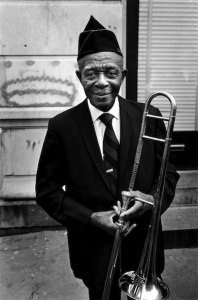
“A Musician from the 369th Regiment Marching Band, 1977,” was taken by Dawoud Bey, which is part of the Harlem, USA collection. When I first came across this image, it gave me a hint of sublime. I’ve traveled many times, and it automatically reminded me of New Orleans. The man in this image may not have the same background story as the people I met at New Orleans, but this image was taken in the late 70’s, only a decade after segregation was over. The was a marching band playing, “When The Saint Go Marching In,” and I went up to talk to him, and we talked about the amount of devastation there were and how playing music for the people is what most do because it helps them escape from what they’re going through at the moment.
Dawoud Bey’s use of line really helps the viewer’s concentration be on the man’s face. This image contains a line gesture, in which the eye is mainly attracted to the trumpet, it is at a slight angle that allows the eye to move upward toward the musician’s face. This photograph doesn’t have much of a frame, but rather a setting that hints at urban area in New York due to the graffiti on his left side. The only patterns in this photograph, again are in the background, created by the bricks of the building and the blinds in the window of the building behind the elderly man. Everything In the image is in focus, meaning the photograph is composed with a deep depth of field; personally I feel it benefits us because it informs us of the setting the musician is in, which adds to his story. The lights in the photograph are mostly in his face, creating highlights on his nose and cheeks, which allow a glowing feel to his mood. The photograph is taken almost at a eye level, rather than a worm’s point of view and bird’s eye view. This allows the viewer to feel as if they’re in the particular setting with the subject of the photograph, almost like you are part of the story.
-
Recent Posts
Recent Comments
Categories




I love New Orleans but I must admit I wouldn’t have thought of New Orleans when looking at this photo. However, certainly some of the heritage of Harlem comes from the South. I think the photo is about the man’s expression, his dignity. This contrast with the graffiti sitting on his shoulder. To me this shows a generational shift.